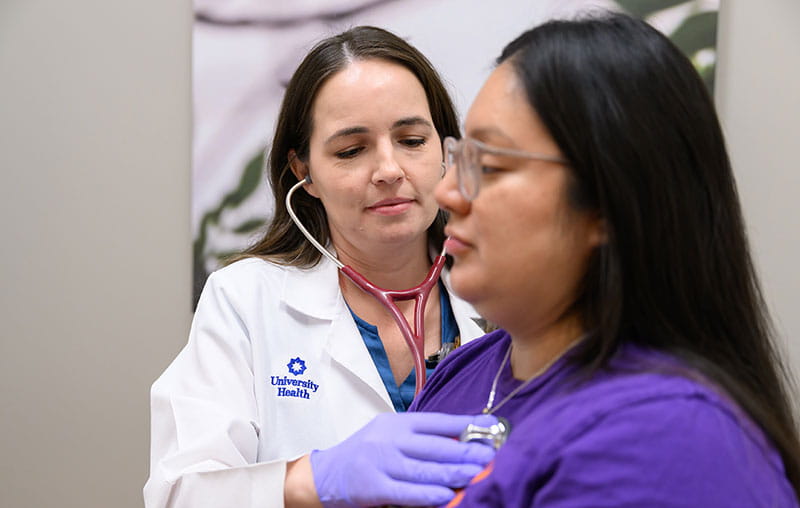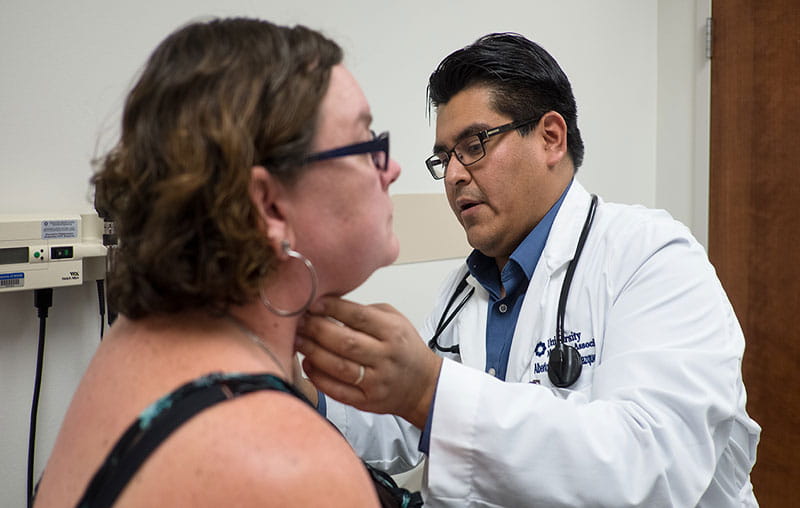We’re all at risk of developing Type 2 diabetes, but some people have a higher risk due to certain factors.
In a recent global study conducted from 2000-2023, 44% of people age 15 and older were living with diabetes and did not know it.
With the rising concern of undiagnosed diabetes, Dr. Alberto Chavez-Velazquez, an endocrinologist with University Health, says living a healthy lifestyle and knowing your risk factors are good places to start. “Understanding what may put you at a higher risk, especially the factors that you can control, allows you to take steps to lower your risk,” Dr. Chavez-Velazquez says.
Understanding Type 2 Diabetes
Diabetes is a chronic medical condition that occurs when your blood sugar level is high. This occurs due to a disruption in the balance between your blood sugar and the production or use of insulin in the body.
“Your pancreas, an organ in your endocrine system, produces insulin, a molecule that transports blood sugar to the inside of cells to be used as energy,” says Dr. Olga Nunez, family practice physician with University Health. “After a meal, your blood sugar levels go up, which signals your pancreas to release insulin.”
With Type 1 diabetes, which has a genetic component, blood sugar is high because the pancreas doesn’t produce insulin properly.
With Type 2 diabetes, on the other hand, blood sugar is high because the body doesn’t metabolize (or use) insulin properly, a condition often referenced as insulin resistance. This causes excessive levels of glucose to build up in the blood rather than being used by the body for energy.
Diabetes is incredibly common in the United States, with 1 in 9 Americans having the condition. That’s more than 38 million people. Of that number, up to 95% have Type 2 diabetes.
Learn more about diabetes care at University Health.
Know Your Risk Factors for Type 2 Diabetes
For Type 2 diabetes, risk factors beyond your control include:
- being age 45 or older
- having a family history of diabetes
- having had gestational diabetes during pregnancy
- being African American, Hispanic or Latino, American Indian or Alaska Native
Controllable Risk Factors
Type 1 diabetes is believed to be associated with an autoimmune disorder, and at this time, there’s no known way to prevent it.
On the other hand, there are ways you can prevent Type 2 diabetes. “Many risk factors for this type of diabetes are what’s known as controllable, meaning they’re things you can change,” Dr. Chavez-Velazquez says.
You’re at a higher risk of developing Type 2 diabetes if you:
- Are overweight or obese
- Don’t get enough quality sleep
- Drink alcohol excessively
- Eat a diet high in saturated fat, added sugar and excess sodium
- Have prediabetes
- Have high blood pressure
- Have high cholesterol
- Have non-alcoholic fatty liver disease
- Have polycystic ovarian syndrome
- Live a sedentary lifestyle
- Smoke
Many Americans have one or more of these risk factors, putting them at an increased risk of developing this form of diabetes. If you’ve been diagnosed with prediabetes, consider that a red flag signaling that Type 2 diabetes may be ahead. Prediabetes means that your blood sugar is elevated, but not quite to the level of diabetes.
“Risk factors for prediabetes are similar to diabetes,” Dr. Nunez says. “Lifestyle modifications have been proven to prevent and even reverse prediabetes.”
How to Prevent Type 2 Diabetes
If you have any of the risk factors above, taking steps to mitigate those factors can help you prevent Type 2 diabetes.
A healthy lifestyle is your best defense. Start by regularly visiting your primary care provider for checkups, including routine lab work. If you have high blood pressure or high cholesterol, work with your provider to lower them into a healthy range.
Other ways you can lower your risk for diabetes are the following:
Exercise
Aim to get at least 150 minutes of moderate physical activity each week. That’s only 22 minutes of exercise each day, such as briskly walking, jogging, dancing or swimming.
Diet
Take a careful look at what’s on your plate, too. Fill half of your plate at meals with fruits and vegetables, supplemented by a small portion of lean protein (like fish, chicken, tofu or eggs) and whole grains. Limit your intake of processed foods, which often contain unhealthy additives like sugar, sodium and saturated fat.
Sleep
Prioritize getting enough quality sleep. Aim for between seven and nine hours of quality sleep each night, adjusting your bedtime habits as needed.
Healthy Habits
You can also lower your risk by including other healthy habits into your routine, such as minimizing your alcohol intake, getting to and maintaining a healthy weight, finding sustainable ways to manage stress and quitting smoking if you smoke.
Diabetes Care at University Health
Your primary care provider can help you manage or prevent diabetes early on. Schedule an appointment with one of our primary care providers today.
If you need additional care, your provider will refer you to an endocrinologist, a diabetes specialist.
At University Health, our San Antonio endocrinologists are some of the best in the nation. We offer the largest and most comprehensive care dedicated to diabetes at the Texas Diabetes Institute.
We also offer diabetes education classes to our patients, as well as exercise programs. For more information, call Texas Diabetes Institute at 210-358-7500.
Community Resources
Whether you receive care from us or not, you can find community resources related to diabetes care through our Institute for Public Health.
Diabetes is a long-term condition that can lead to serious complications
Take our Diabetes Health Risk Assessment to help you understand your risk for Type 2 diabetes and learn steps you can take to lower it.






